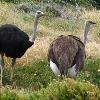

Male and Female ostriches Cape Point Tags: Ostrich View |
S. camelus species_authority = (Linnaeus (Carolus Linnaeus), 1758) binomial = Struthio camelus binomial_authority = (Linnaeus, 1758) range_map = Struthio camelus Distribution.png range_map_width = 250px range_map_caption = Distribution subdivision_ranks = Subspecies subdivision = S. camelus australus (Gurney (John Henry Gurney), 1868)Southern Ostrich S. camelus camelus (Linnaeus, 1758)North African Ostrich S. camelus massaicus (Neumann (Oscar Rudolph Neumann), 1898)Masai Ostrich ?S. camelus syriacus (Arabian Ostrich) (Rothschild (Lionel Walter Rothschild, 2nd Baron Rothschild), 1919)Arabian Ostrich S. camelus molybdophanes (Reichenow, 1883)Somali Ostrich
The Ostrich, Struthio camelus, is a large flightless bird native to Africa. It is the only living species of its family (family (biology)), Struthionidae and its genus, Struthio. Ostriches share the order (order (biology)) Struthioniformes with the kiwis, Emus, and other ratites. It is distinctive in its appearance, with a long neck and legs and the ability to run at maximum speeds of about 70 km/h (45 mph), the top land speed of any bird. The Ostrich is the largest living species (Largest organisms) of bird and lays the largest egg of any living bird (extinct elephant birds of Madagascar and giant moa of New Zealand laid larger eggs).
The diet of the Ostrich mainly consists of plant matter, though it also eats insects. It lives in nomadic groups which contain between five and fifty birds. When threatened, the Ostrich will either hide itself by lying flat against the ground, or will run away. If cornered, it can attack with a kick from its powerful legs. Mating patterns differ by geographical region, but territorial males fight for a harem of two to seven females.
The Ostrich is farmed (farming) around the world, particularly for its feathers, which are decorative and are also used as feather dusters. Its skin is used for leather products and its meat marketed commercially.
Fossil Range: fossil rangepleistocenepresent Pleistocene to Recent
Status System: iucn3.1
Status Ref:
Regnum: Animalia
Phylum: Chordata (Chordate)
Subphylum: Vertebrata (Vertebrate)
Classis: Aves (Bird)
Superordo: Paleognathae
Ordo: Struthioniformes
Familia: Struthionidae
Genus: ''Struthio''

